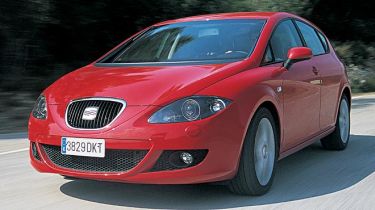SEAT Leon 2005 review
As the maker of some of today's best-looking cars, SEAT has come a long way since the bargain hatchbacks of the early Nineties.
SEAT's line-up includes some of the most stylish models on the market, and the new Leon is just as striking as its stablemates. It looks good, handles well and is set to be cheaper than many rivals. The competition is fierce in this segment, however, with Ford, VW and Vauxhall all offering capable and more established rivals in the form of the Focus, Golf and Astra.
As the maker of some of today's best-looking cars, SEAT has come a long way since the bargain hatchbacks of the early Nineties. The days of being the poor relation in the Volkswagen Group are long gone, but can the introduction of an all-new Leon attract more buyers to the brand?
The latest five-door model continues SEAT's trend for swooping, heavily stylised lines and almond-shaped, feline headlights. From the front, the Leon is almost indistinguishable from its Altea and Toledo stablemates, but a squat, sporty stance at the rear sets it apart.
From behind, there is no denying the designers were heavily influenced by Alfa Romeo. Passers-by are likely to do a double take to convince themselves that they are looking at a Leon and not a 147. That said, bearing a strong resemblance to the attractive Italian hatchback is no bad thing.
Alfa's influence does not end there. As on the 156 saloon, the Leon's rear door handles are hidden within the C-pillars to give the car the appearance of a sporty three-door. Overall, the effect is of an aggressive-looking machine - and one that's far more striking than VW's Golf MkV, with which it shares a platform.
Inside, the dash will be familiar to Altea drivers. But just because the Leon shares many of the MPV's parts does not mean that it is as family friendly. It is spacious, yet the Leon is a sporty hatch - the rear seats fold, but they do not slide, while the spacious boot has a comparatively narrow opening. There are a few cheap materials in evidence, too.
In the Sport-up trim, seen here, the impressive array of gizmos and gadgets includes two-zone climate control, as well as cruise control and steering wheel-mounted switches for the stereo. There is also plenty of room for occupants' heads and legs.
Five engines will be available when the new Leon goes on sale in September. The pick of the bunch is the 2.0-litre TDI turbodiesel, which develops 138bhp and 320Nm of torque. In each of its six gears acceleration is excellent, and the SEAT cruises effortlessly at motorway speeds. Indeed, the unit is such a competent all-rounder that there is little reason for picking the 1.9-litre oil-burner, save for a nominal fuel economy gain. If diesel is not your thing, the most powerful of the three petrol variants is the 2.0-litre FSI, which is already proving to be popular in the Golf.
Although it cannot quite match the TDI for torque, the power delivery is smoother, and the FSI offers far more refinement than the diesel. Through corners, the Leon feels poised and sure-footed. With a nimble, agile chassis, it loses its grip only when driven hard, and even then it does not feel unstable. But can the Leon snatch the family hatchback crown from Ford's Focus? If styling is top of your priority list, the SEAT could be well worth a look. Yet a sharp design alone will not take it to the top of the sales charts. Equally important is the manufacturer's plan to undercut most rivals on price, and that could be the deciding factor.
However, the Leon is competing in an image-conscious sector, and for many the big 'S' on the bonnet cannot quite muster the allure of the coveted VW.



